Swap your traditional apple pie for this delicious Pear Ginger Pie. It's great all fall and winter long, and a welcome addition to holiday menus.
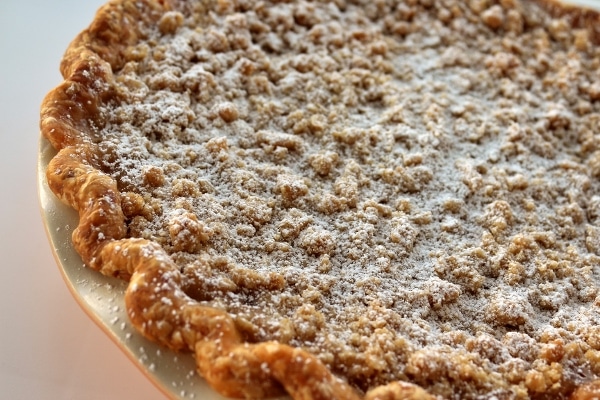
This Pear Ginger Oatmeal Crumb Pie is actually one I would consider to be one of my top four sweet pies, which is saying a lot. This pie pretty much kicks any apple pie's butt, in my opinion. Although I love apple pie it lacks excitement for me. It's just kind of Plain Jane even when it's jazzed up a bit (no offense, apple, but you've had your time in the spotlight).
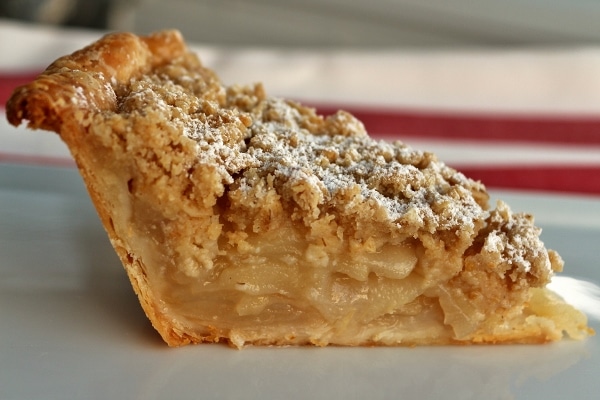
Pear is a nice twist to a fall/winter fruit for pie making. In this particular case, thinly sliced pears make for a very delicate, not too sweet filling which is nicely complimented with a crumbly oat topping.
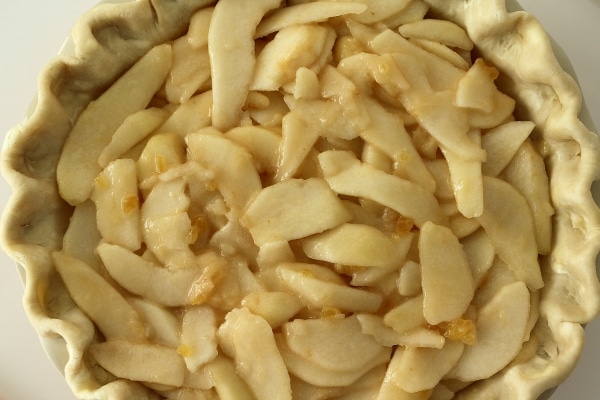

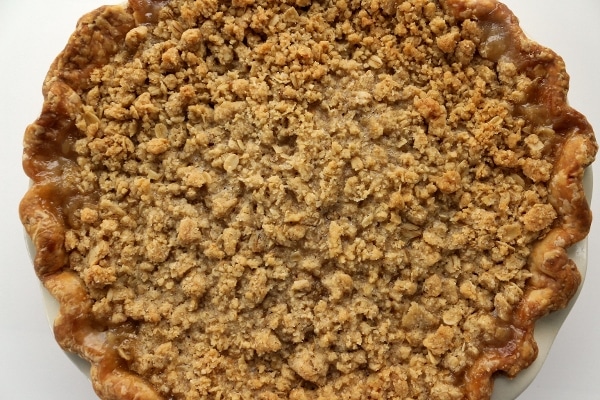
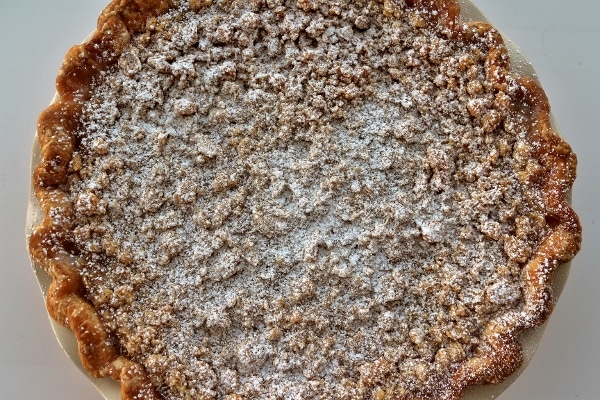
I actually ordered this pie when I visited Magpie in Philadelphia in the fall of 2016. Later, when I purchased the Magpie cookbook I added it to my list of recipes to try.
May I be so bold as to say that I prefer the pie I made to the one I purchased at Magpie! I liked the pie at Magpie, but I LOVED the one I baked.
One of the differences is that they leave the skin on the pears at Magpie, but I peeled my pears which yielded a less rustic filling. It was simply more refined and delicate in texture and flavor. I just preferred it that way. It was stunning.
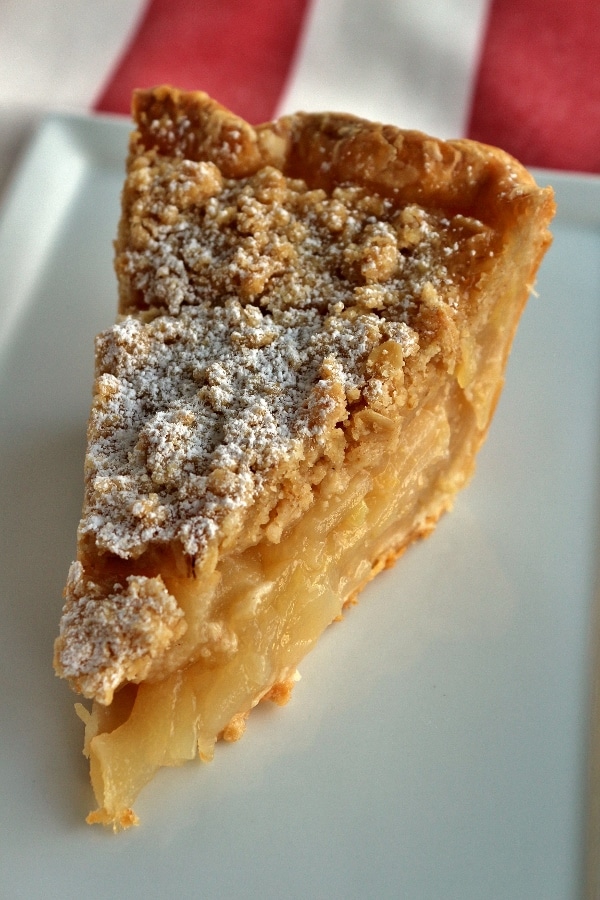
Ginger is the other key ingredient in the filling. It comes in the form of finely diced candied/ crystallized ginger, which is much less assertive than the fresh version.
There is also ground ginger in the topping. This gives the pie just that hint of ginger flavor without overpowering the pears.

I'd also like to add that the Magpie pie crust recipe is one of my favorites. It's mostly butter with just a bit of shortening (I use Spectrum non-hydrogenated organic shortening). Both fats are cubed and frozen and then blitzed in the food processor, yielding nice crumbs without overworking or overheating the fats.
Each fat offers something special to the dough, so using a combination of the two is a nice way to go. I like leaning more on the butter which offers the bulk of the flavor here, while the shortening plays a supporting role with its flakiness and structure.
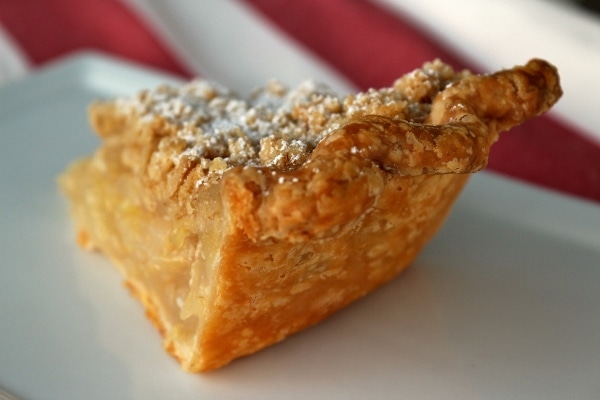 |
| Perfect, flaky, golden pie crust |
Other recipes you may like
- Hummingbird Pie
- Brown Butter Pumpkin Pie
- Cranberry Sage Pie
- Malted Chocolate Pecan Pie
- Peppermint Mousse Black Bottom Pie
- Blueberry Nectarine Pie
Tried this recipe? Please leave a star ⭐️⭐️⭐️⭐️⭐️ rating in the recipe card below and/or a review in the comments section further down the page. You can also follow me on social media on Facebook, Instagram, and Pinterest!
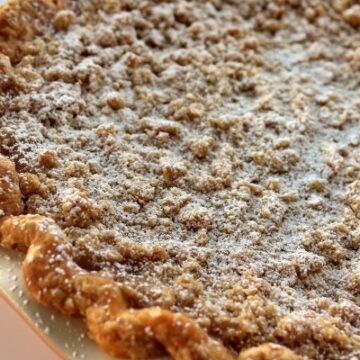
Pear Ginger Oatmeal Crumb Pie
Ingredients
Oatmeal Crumb:
- 1 cup (80 grams) rolled oats, divided
- ½ cup (62 grams) all-purpose flour
- ½ cup (96 grams) granulated sugar
- 1 teaspoon ground ginger
- ¼ teaspoon ground or freshly grated nutmeg
- ¼ teaspoon kosher salt
- 5 tablespoons (71 grams) unsalted butter, melted and cooled
Pie:
- ½ recipe Magpie Dough for Flaky Piecrust chilled overnight (recipe follows)
- 3 pounds (1360 grams) firm, ripe, peeled Bartlett pears, cored and sliced ⅛-inch thick
- 1 tablespoon freshly squeezed lemon juice
- 2 teaspoons vanilla extract
- ⅓ cup (63 grams) granulated sugar
- 2 tablespoons plus 1 teaspoon cornstarch
- 2 tablespoons minced candied/crystallized ginger
- ⅛ teaspoon fine salt
Instructions
- For the oatmeal crumb: Use a food processor to grind ¾ cup of the oats, pulsing the machine until the oats resemble coarse cornmeal. Add the flour, sugar, ginger, nutmeg, and salt and pulse 5 times to combine. Transfer the mixture to a bowl and whisk in the remaining ¼ cup whole oats.
- Add the melted butter and blend with a fork or your fingers until the butter is incorporated and the mixture gathers into small clumps. Set the bowl in the refrigerator and chill the crumb for 15 minutes before topping your pie.
- For the pie: Lightly flour a smooth work surface and a rolling pin.
- Take a chilled disk of dough out of the fridge. Give it a couple of firm squeezes just to say hello, then unwrap it and set it on the floured work surface.
- Set the pin crosswise on the dough and press down firmly, making a nice deep channel across the full width of the disk. Turn the disk 180 degrees and repeat, making a second indentation, forming a plus sign.
- Use your rolling pin to press down each of the wedges, turning the dough 45 degrees each time. This will give you the beginnings of a thick circle.
- Now, rolling from the center outward and rotating the dough a quarter turn to maintain a circular shape, roll the dough out to a 13-inch circle with an even thickness of ¼ inch.
- Set your 9-inch (23-cm) pie pan alongside the circle of dough. Brush off any loose flour, carefully fold the dough circle in half, transfer it to the pan, and unfold.
- At this point, the dough will be lying across rather than fitted into the pan. Now, without stretching the dough, set the dough down into the pan so that it is flush up against the sides and bottom. The best way to do this is to gingerly lift the dough and gently shift it around so that it settles into the pan bit by bit. Use a very light touch to help cozy it in.
- To flute the edge, fold the overhang under to form a 1-inch wall that rests on the lip of the pan with the seam slightly below the pan’s top edge. Go around the edge of the pan and use a very light touch to firm up the wall to an even thickness from the bottom to the top and all the way around. Flute the edge of the crust at about 1-inch intervals, pressing from the inside with the knuckle of your index finger while supporting on the outside with the thumb and index finger of your opposite hand. Don’t pinch the dough, you want the flute to look like a thick rope.
- Transfer the crust to the refrigerator to chill while you make your filling. Alternatively, at this point the crust can be covered tightly in plastic wrap and refrigerated for up to 3 days or double-wrapped and frozen for up to 2 months (defrost overnight in the refrigerator before filling and baking or prebaking, or at room temperature for 30 minutes).
- Preheat the oven to 375°F with a rack in the center. Line a rimmed baking sheet with parchment paper or foil. (I actually pre-heated my baking sheet in the oven until ready to bake the pie).
- In a large bowl, toss the pears with the lemon juice and vanilla.
- In a small bowl, whisk together the sugar, cornstarch, candied ginger, and salt. Sprinkle the sugar mixture over the pears and toss to coat the fruit and moisten the sugar and cornstarch so that no dry white streaks remain.
- Retrieve the prepared pie shell from the refrigerator and set the pan on the parchment-lined baking sheet. Scoop the filling into the shell and top with the oatmeal crumb, spreading evenly and completely covering the fruit.
- Transfer the baking sheet to the oven and bake the pie 25 minutes, then rotate the baking sheet, lower the oven temperature to 350°F, and bake 25 to 30 minutes more, or until the topping is golden and the juices bubble up through the crumb (all of my pies bake longer than recipes suggest–mine baked an extra 25 minutes beyond, a total of 55 minutes at the lower temperature–but just look for the signs and don’t count on the timer to always be right). Tent the top with foil if it starts to over-brown.
- Set the baking sheet on a wire rack and let the pie cool and set, uncovered, at room temperature, overnight (or up to 3 days) before slicing and serving (mine cooled about 4 to 6 hours, which was plenty of time for it to set while retaining its flaky crust; I also dusted mine with confectioners’ sugar before serving).
Notes
Nutrition
*All nutritional information is based on third-party calculations and should be considered estimates. Actual nutritional content will vary with brands used, measuring methods, portion sizes and more.*
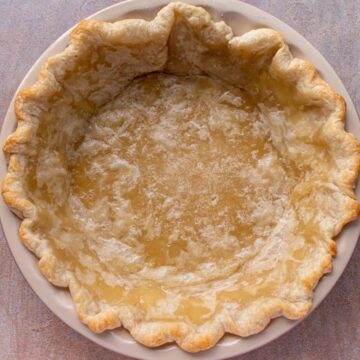
The Best Dough for Flaky Piecrust
Ingredients
- 2 ½ cups (312 grams) all-purpose flour
- 2 tablespoons (28 grams) granulated sugar
- 1 teaspoon (6 grams) salt
- ¾ cup (170 grams) cold unsalted butter cut into ¼-inch cubes and frozen
- ¼ cup (60 grams) vegetable shortening preferably in baking stick form, frozen, cut into ¼-inch pieces, and put back in the freezer
- ½ cup plus 1 tablespoon (130 grams) ice-cold water
Instructions
- Combine the flour, sugar, and salt in the bowl of a food processor and pulse 3 times to blend. Scatter the frozen butter cubes over the flour mixture. Pulse the machine 5 to 7 times, holding each pulse for a 5 full seconds, to cut all of the butter into pea-size pieces.
- Scatter the pieces of frozen shortening over the flour-and-butter mixture. Pulse the machine 4 more 1-second pulses to blend the shortening with the flour. The mixture will resemble coarse cornmeal, but will be a bit more floury and riddled with pale butter bits (no pure-white shortening should be visible).
- Turn the mixture out into a large mixing bowl, and make a small well in the center. If you find a few butter clumps that are closer to marble size than pea size (about ¼ inch in diameter), carefully pick them out and give them a quick smoosh with your fingers. Pour the cold water into the well.
- Use a curved bowl scraper to lightly scoop the flour mixture up and over the water, covering the water to help get the absorption started. Continue mixing by scraping the flour up from the sides and bottom of the bowl into the center, rotating the bowl as you mix, and occasionally pausing to clean off the scraper with your finger or the side of the bowl, until the mixture begins to gather into clumps but is still very crumbly. (If you are working in very dry conditions and the ingredients remain very floury and refuse to clump together at this stage, add another tablespoon of ice-cold water.)
- Lightly gather the clumps with your fingers and use your palm to fold over and press the dough a few times (don’t knead! —just give the dough a few quick squishes), until it just begins to come together into a single large mass.
- For single- and double-crust pies, mini pies, potpies, or hand pies: Divide the dough into 2 equal portions, gently shape each portion into a flat disk 1 ½ to 2 inches thick, and wrap each tightly with plastic wrap. For quiche, leave the dough in one piece, flatten it into a single large disk 1 ½ to 2 inches thick, and wrap tightly with plastic wrap.
- Refrigerate the dough for at least 8 hours or up to 3 days before rolling. (The dough may discolor slightly. No worries. This is merely oxidization and will not affect the flavor or appearance of your finished piecrust.)
Notes
- The wrapped, chilled dough can be put in a freezer bag and frozen for up to 2 months. Defrost overnight in the refrigerator before rolling.
- Adapted from Magpie
*All nutritional information is based on third-party calculations and should be considered estimates. Actual nutritional content will vary with brands used, measuring methods, portion sizes and more.*

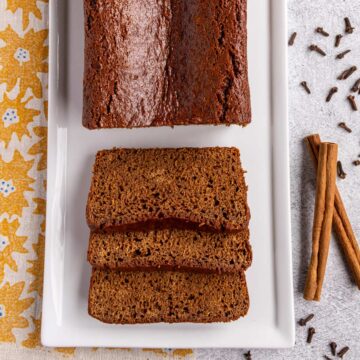

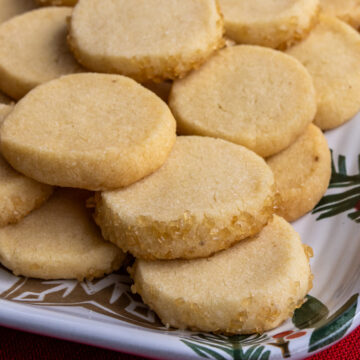
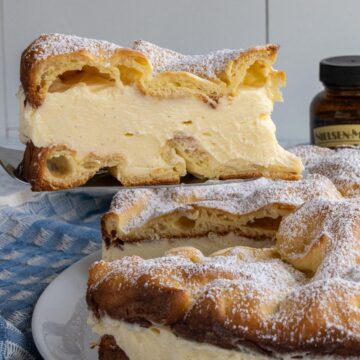
Comments
No Comments